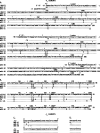Complete sequence of the genes encoding the VH and VL regions of low- and high-affinity monoclonal IgM and IgA1 rheumatoid factors produced by CD5+ B cells from a rheumatoid arthritis patient
- PMID: 1718404
- PMCID: PMC4632984
- DOI: 10.1093/intimm/3.9.865
Complete sequence of the genes encoding the VH and VL regions of low- and high-affinity monoclonal IgM and IgA1 rheumatoid factors produced by CD5+ B cells from a rheumatoid arthritis patient
Abstract
We have characterized the VH and VL genes of three low-affinity polyreactive and two high-affinity monoreactive IgM and IgA1 rheumatoid factor (RF) mAb generated using circulating CD5+ B cells from a single rheumatoid arthritis patient. We found that four and one RF mAb utilized genes of the VHIV and VHIII families, respectively. The VHIV gene usage by these RF mAb differs from the preferential VHIII, VHI, and, to a lesser extent, VHII gene usage by the IgM with RF activity found in patients with mixed cryoglobulinemia, Waldenstrom's macroglobulinemia, and other monoclonal gammopathies. In addition, in contrast to the preponderant kappa L chain usage by the RF in these patients, a lambda L chain was utilized by all RF mAb from our rheumatoid arthritis patient. Two RF mAbs utilized V lambda I, two V lambda IV, and one V lambda III L chains. The VH genes of the two low-affinity polyreactive IgM RF mAb were in germline configuration. When compared with the deduced amino acid sequence of the putatively corresponding genomic segment, the VH gene of the high-affinity monoreactive IgM RF mAb displayed five amino acid differences, all of which are in the complementarity determining regions (CDR), possibly the result of a process of somatic point mutation and clonal selection driven by Ag. The unavailability of the corresponding genomic VH segment sequences made it impossible to infer whether the VH genes utilized by the two IgA1 RF were in a germline or somatically mutated configuration. Sequencing of the genes encoding the H chain CDR3 (D segments) revealed that all three low-affinity polyreactive RF mAb displayed a much longer D segment (36-45 bases) than their high-affinity monoreactive counterparts (15-24 bases), raising the possibility that a long D segment may be one of the factors involved in antibody polyreactivity.
Figures



References
-
- Waaler E. On the occurrence of a factor in human serum activating the specific agglutination of sheep Wood corpuscles. Ada Path. Microbioi. Scand. 1940;17:172. - PubMed
-
- Rose HM, Ragan C, Pearce E, Lipman MO. Differential agglutination of normal and sensitized sheep erythrocytes by sera of patients with rheumatoid arthritis. Proc. Soc Exp. Biot. Med. 1949;68:1. - PubMed
-
- Zvaifler NJ. The immunopathology of joint inflammation in rheumatoid arthritis. Adv. Immunol. 1973;13:265. - PubMed
-
- Carson DA, Chen PP, Fox RI, Kipps TJ, Jirik F, Goldfien RD, Sil verman G, Radoux V, Fong S. Rheumatoid factors and immune networks. Annu. Rev. Immunol. 1987;5:109. - PubMed
-
- Lambert PH, Casali P. Immune complexes in rheumatic diseases. Clin. Rheum. Dis. 1978;4:617.
Publication types
MeSH terms
Substances
Associated data
- Actions
- Actions
- Actions
- Actions
- Actions
- Actions
- Actions
- Actions
- Actions
- Actions
- Actions
Grants and funding
LinkOut - more resources
Full Text Sources
Other Literature Sources
Medical

